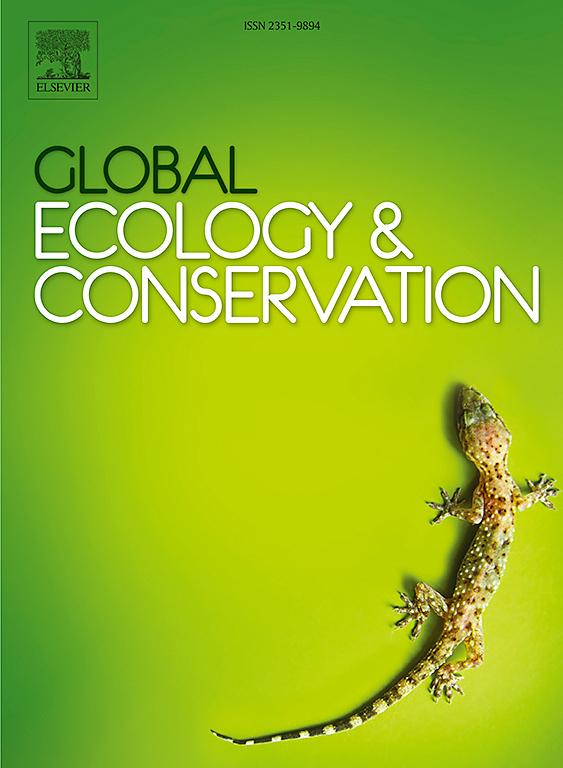Behavioural adaptability of wild geladas (Theropithecus gelada) in human-impacted areas revealed by encounters with free-roaming dogs and potential threats
IF 3.4
2区 环境科学与生态学
Q1 BIODIVERSITY CONSERVATION
引用次数: 0
Abstract
Studying interactions between domestic species and wild primates is crucial for understanding the impacts of human expansion on wildlife. While free-roaming domestic dogs are one of the most common human-introduced carnivores and pose potential threats to primates, their direct influence on primate behaviour remains largely overlooked. Geladas (Theropithecus gelada), a primate species endemic to Ethiopia's Afro-alpine grasslands with a specialized diet, are facing challenges from habitat loss and interactions with domestic animals throughout their geographical range. Here, we followed 17 gelada group units in an unprotected area of Ethiopia (6-month period, 598 h of observation) and explored their behavioural responses to different natural and human-related threats. We observed strong vigilance in response to the presence of humans chasing nearby groups, as well as in response to dogs and eagles. Other raptors and birds of prey (including vultures and kites) produced no vigilance response, or only a modest one (e.g., augur buzzard). We also report encounters and interactions (n = 16) between dogs and geladas. Although we observed some behaviours associated with agonism and anxiety from both sides, the presence of dogs at close proximity was mainly tolerated. This contrasts with data from populations inhabiting protected areas where geladas typically exhibit flight responses to encounters with dogs. These differences between populations hint at gelada behavioural plasticity to adapt and live in human-impacted environments with limited alternative feeding sites. Increased awareness and documentation of dog-primate interactive events are essential to better grasp the broader implications of human-wildlife coexistence, one of the most important challenges of the Anthropocene.
野生狒狒(Theropithecus gelada)在人类影响地区的行为适应性,通过与自由漫游的狗和潜在威胁的接触揭示
研究家养物种与野生灵长类动物之间的相互作用对于理解人类扩张对野生动物的影响至关重要。虽然自由漫游的家狗是最常见的人类引入的食肉动物之一,对灵长类动物构成潜在威胁,但它们对灵长类动物行为的直接影响在很大程度上被忽视了。狒狒(Theropithecus gelada)是埃塞俄比亚非洲高山草原特有的一种灵长类动物,具有特殊的饮食,正面临栖息地丧失和与整个地理范围内的家畜相互作用的挑战。在这里,我们在埃塞俄比亚一个未受保护的地区对17个狒狒群体进行了为期6个月,598 小时的观察,并探讨了它们对不同自然和人类相关威胁的行为反应。我们观察到,对于人类追赶附近群体的反应,以及对狗和鹰的反应,它们都具有很强的警惕性。其他猛禽和猛禽(包括秃鹫和风筝)没有警觉反应,或者只有一个适度的警觉反应(例如,占卜秃鹰)。我们也报道了狗和狒狒之间的相遇和互动(n = 16)。虽然我们观察到双方的一些与激动和焦虑相关的行为,但狗的近距离存在主要是容忍的。这与居住在保护区的狒狒的数据形成鲜明对比,在保护区,狒狒遇到狗时通常表现出逃跑反应。种群之间的这些差异暗示了狒狒的行为可塑性,以适应和生活在受人类影响的环境中,替代的觅食地点有限。提高对狗与灵长类动物互动事件的认识和记录,对于更好地把握人类与野生动物共存的更广泛含义至关重要,这是人类世最重要的挑战之一。
本文章由计算机程序翻译,如有差异,请以英文原文为准。
求助全文
约1分钟内获得全文
求助全文
来源期刊

Global Ecology and Conservation
Agricultural and Biological Sciences-Ecology, Evolution, Behavior and Systematics
CiteScore
8.10
自引率
5.00%
发文量
346
审稿时长
83 days
期刊介绍:
Global Ecology and Conservation is a peer-reviewed, open-access journal covering all sub-disciplines of ecological and conservation science: from theory to practice, from molecules to ecosystems, from regional to global. The fields covered include: organismal, population, community, and ecosystem ecology; physiological, evolutionary, and behavioral ecology; and conservation science.
 求助内容:
求助内容: 应助结果提醒方式:
应助结果提醒方式:


